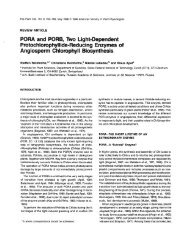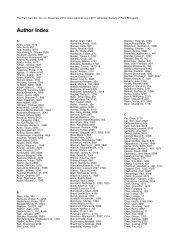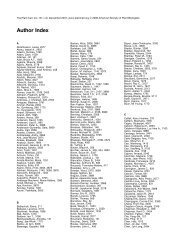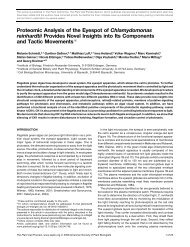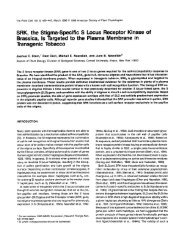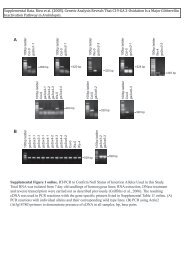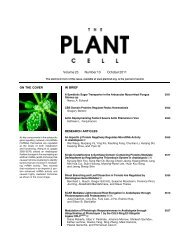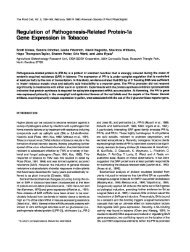The Shikimate Pathway: Early Steps in the ... - The Plant Cell
The Shikimate Pathway: Early Steps in the ... - The Plant Cell
The Shikimate Pathway: Early Steps in the ... - The Plant Cell
Create successful ePaper yourself
Turn your PDF publications into a flip-book with our unique Google optimized e-Paper software.
912 <strong>The</strong> <strong>Plant</strong> <strong>Cell</strong><br />
<strong>Plant</strong> chorismate synthase was first demonstrated <strong>in</strong> pea<br />
chloroplasts (Mousedale and Cogg<strong>in</strong>s, 1986) and purified to<br />
homogeneity from cells of Corydalis sempefvirens (Schaller<br />
et al., 1990). <strong>The</strong> first plant cDNA encod<strong>in</strong>g chorismate syn-<br />
thase was isolated by expression clon<strong>in</strong>g us<strong>in</strong>g a polyclonal<br />
antibody raised aga<strong>in</strong>st this enzyme (Schaller et al., 1991a).<br />
This cDNA and two tomato homologs (G8rlach et al., 1993b)<br />
encode polypeptides with N-term<strong>in</strong>al extensions that resem-<br />
ble transit peptides for chloroplast import.<br />
QUINATE DEGRADATION<br />
At least two <strong>in</strong>termediates of <strong>the</strong> biosyn<strong>the</strong>tic pathway toward<br />
chorismate, 3-dehydroqu<strong>in</strong>ate and 3-dehydroshikimate, are<br />
also <strong>in</strong>termediates <strong>in</strong> <strong>the</strong> degradation of qu<strong>in</strong>ate. Figure 3 shows<br />
this metabolite as a precursor of chlorogenate, which accumu-<br />
lates <strong>in</strong> severa1 plants (for example, coffee bean), to substantial<br />
levels. Although <strong>the</strong> accumulation of qu<strong>in</strong>ate appears to be<br />
restricted to specific plants, <strong>the</strong> occurrence of chlorogenate<br />
and its derivatives is more widespread. Chlorogenate is <strong>the</strong><br />
major soluble phenylpropanoid <strong>in</strong> tobacco and a preformed<br />
protectant aga<strong>in</strong>st fungal attack (Maher et al., 1994). It con-<br />
tributes to general plant health as part of a physical and<br />
possibly also a chemical barrier aga<strong>in</strong>st microbial attack. Once<br />
this barrier is broken, <strong>the</strong> constituents become potential car-<br />
bon sources for <strong>the</strong> attacker.<br />
Dur<strong>in</strong>g a careful analysis of fungal mutants with lesions <strong>in</strong><br />
<strong>the</strong> genes encod<strong>in</strong>g biosyn<strong>the</strong>tic shikimate pathway enzymes,<br />
Giles et al. (1985) detected a catabolic pathway for qu<strong>in</strong>ate,<br />
which, along with shikimate, is readily degraded by fungi and<br />
some bacteria, first to protocatechuate and ultimately to suc-<br />
c<strong>in</strong>ate and acetyl-COA. In fact, N. crassa (Giles et al., 1985),<br />
A. nidulans (Grant et al., 1988), and Rhodococcus rhodochrous<br />
(Bruce and Ca<strong>in</strong>, 1990) can all use qu<strong>in</strong>ate (or shikimate) as<br />
<strong>the</strong>ir only carbon source.<br />
<strong>The</strong> first three steps of qu<strong>in</strong>ate catabolism are an NAD-<br />
gependent oxidation to 3-dehydroqu<strong>in</strong>ate followed by two<br />
dehydrations, first to Sdehydroshikimate and <strong>the</strong>n to protocate-<br />
chuate. <strong>The</strong> enzymes catalyz<strong>in</strong>g <strong>the</strong>se reactions are qu<strong>in</strong>ate<br />
dehydrogenase, 3-dehydroqu<strong>in</strong>ate dehydratase, and 3-dehy-<br />
droshikimate dehydratase, respectively. <strong>The</strong>ir primary<br />
structures have been deduced from <strong>the</strong> correspond<strong>in</strong>g gene<br />
sequences (Giles et al., 1985; Grant et al., 1988). <strong>The</strong> qu<strong>in</strong>ate<br />
dehydrogenase also oxidizes shikimate to 3-dehydroshikimate.<br />
This NAD-dependent enzyme activity of a shikimate dehydro-<br />
genase is different from that of <strong>the</strong> anabolic NADP-dependent<br />
isoenzyme. Catabolic and anabolic shikimate dehydrogenases<br />
are structurally different, even though <strong>the</strong>y share some se-<br />
quence similarities (Anton and Cogg<strong>in</strong>s, 1988). Most but not<br />
all catabolic qu<strong>in</strong>ate dehydrogenases are NAD dependent; one<br />
exception is qu<strong>in</strong>ate dehydrogenase of Ac<strong>in</strong>etobacter calco-<br />
aceticus, which oxidizes qu<strong>in</strong>ate and shikimate to <strong>the</strong>ir<br />
3-dehydro derivatives (Kleef and Du<strong>in</strong>e, 1988) us<strong>in</strong>g as a co-<br />
factor pyrrolo-qu<strong>in</strong>ol<strong>in</strong>e qu<strong>in</strong>one (Du<strong>in</strong>e and Jongejan, 1989;<br />
Elsemore and Ornstrom, 1994).<br />
XAD<br />
OH<br />
Qu<strong>in</strong>ate<br />
OuOH<br />
6H OH<br />
Dchydroqu<strong>in</strong>atc Shikimatc<br />
0 uOH :<br />
OH<br />
Dchydroshikimate<br />
COOH<br />
Q<br />
I<br />
HO<br />
ÓH<br />
Protocatechuate<br />
I<br />
Succ<strong>in</strong>atc Acelyl COA<br />
Figure 3. Metabolic lntermediates of <strong>the</strong> <strong>Shikimate</strong> <strong>Pathway</strong> <strong>in</strong> Qu<strong>in</strong>ate<br />
Syn<strong>the</strong>sis and Degradation.<br />
<strong>The</strong> enzymes of <strong>the</strong> qu<strong>in</strong>ate cycle are (1) qu<strong>in</strong>ate (shikimate) dehydroge-<br />
nase; (2) 3-dehydroqu<strong>in</strong>ate dehydratase; and (3) qu<strong>in</strong>ate hydrolyase.<br />
SDehydroshikimate is aromatized to protocatechuate by Sdehydroshiki-<br />
mate dehydratase (4). Bold arrows <strong>in</strong>dicate reactions of <strong>the</strong> ma<strong>in</strong> trunk<br />
of <strong>the</strong> shikimate pathway.<br />
<strong>The</strong> second enzyme of fungal qu<strong>in</strong>ate degradation, <strong>the</strong><br />
3-dehydroqu<strong>in</strong>ate dehydratase, is also structurally different from<br />
<strong>the</strong> biosyn<strong>the</strong>tic isoenzyme, which is encoded by part of <strong>the</strong><br />
arom cluster described previously. <strong>The</strong> third enzyme <strong>in</strong> this<br />
catabolic sequence, <strong>the</strong> 3-dehydroshikimate dehydratase,<br />
catalyzes a syn elim<strong>in</strong>ation of water to yield protocatechuate<br />
(Scharf et al., 1971). Thus, fungi have clearly separated path-<br />
ways for <strong>the</strong> biosyn<strong>the</strong>sis of <strong>the</strong> aromatic am<strong>in</strong>o acids and <strong>the</strong>




